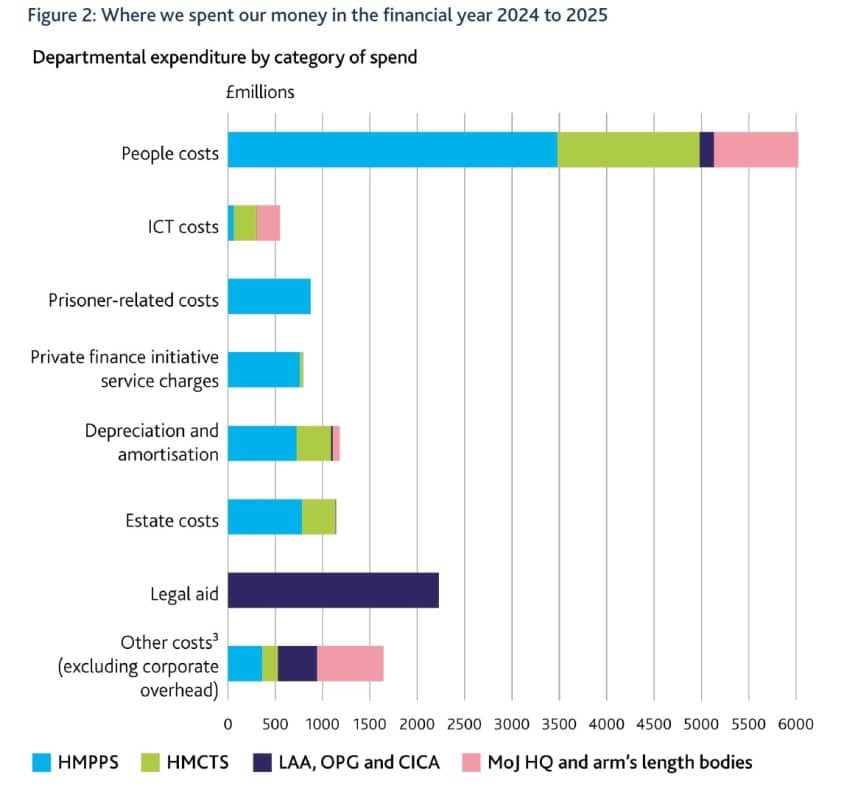The MoJ has just (30 October 2025, updated on 11 November) published its annual report and accounts for the last (24/25) financial year. It’s a blog tradition that I trawl through its (rarely thrilling) contents – all 314 pages – in an effort to unearth some noteworthy nuggets of information. I hope you find them interesting . The MoJ is responsible for no fewer that 31 executive agencies and other arm’s length bodies. The big five, which deliver the bulk of the department’s services, are almost certainly well known to readers:
- HM Prison and Probation Service (HMPPS)
- HM Courts and Tribunals Service (HMCTS)
- Legal Aid Agency (LAA)
- Office of the Public Guardian (OPG)
- Criminal Injuries Compensation Authority (CICA)
The other 26 include everything from the YJB & Parole Board through the justice inspectorates (& IMBs), Sentencing Council & Law Commission to the Judicial Appointments and Conduct Ombudsman and Assessor of Compensation for Miscarriages of Justice.
Finances
The department’s total resource budget for the financial year 2024 to 2025 was £13 billion and total capital budget £1.7 billion. In terms of expenditure, HMPPS is the largest body within MoJ, followed by HMCTS and LAA. The department invests over 80% of its resource funding and over 75% of its capital funding in these three agencies.
The majority of MoJ’s resource budget is spent on running prison and probation services, the courts and tribunals system, and funding on legal aid. As readers will know, the department continued to face significant financial pressures, reflecting both demand coming into the justice system, the impact of inflation on core goods and services, and pay demands being higher than planned for at Spending Review 2021. The chart I have reproduced below show how the MoJ spent its money last year.
Capital spending
The MoJ subsidised the shortfall in its operational budget from its capital budget but still spent £1.44bn, mainly on the prison build programme. By the end of the financial year, 6,500 prison places had been delivered, including opening new houseblocks at HMP Rye Hill. Construction was also completed on the new 1,500-place HMP Millsike, which received its first prisoner in April 2025.
The rest of the capital budget was spent on maintenance costs for the courts and tribunals, prisons and MoJ HQ estates, leases, and digital and technology. The department invested £240m in maintenance, renewal and renovation of the operational prisons and probation estate and £125m in the courts and tribunals estate, of which £40m was spent on major refurbishments and new building projects.
Spending review
The annual report shows the increases agreed in the spending review for the different parts of the MoJ,. Below I show the increases for the current (2025/26) financial year compared to last year’s outturn (the actual amount spent):
Head office (“policy, corporate services and associated offices”) £1.41bn up from £1.02bn
HMPPS £6.14bn up from £5.68bn
HMCTS £2.56bn up from £2.4bn
LAA £2.19bn down from £2.28bn
Parole Board £33.3m up from £31.8m
YJB £107m up from £104m
Interestingly the accounts reveal that it cost £12.3m to run the Oasis Secure School in 2024/25 – there is no projected figure for the current year, presumably because the school is currently closed.
Remuneration
Antonia Romeo (now running the Home Office) received a total package of £270,000 for running the department.
Amy Rees was paid £260k including £15-20k in bonuses for running HMPPS
Nick Goodwin received £230k for running HMCTS
Staffing
Two thirds of the department’s staff (65,783 full-time equivalent) work for HMPPS with 16% for HMCTS and 9% at HQ. 58% of people working within the MoJ are women, although only 51% of senior civil servants. 81% of MoJ staff are white, although this jumps to 91% of senior civil servants. 18% staff reported that they have a disability (14% of senior staff).



